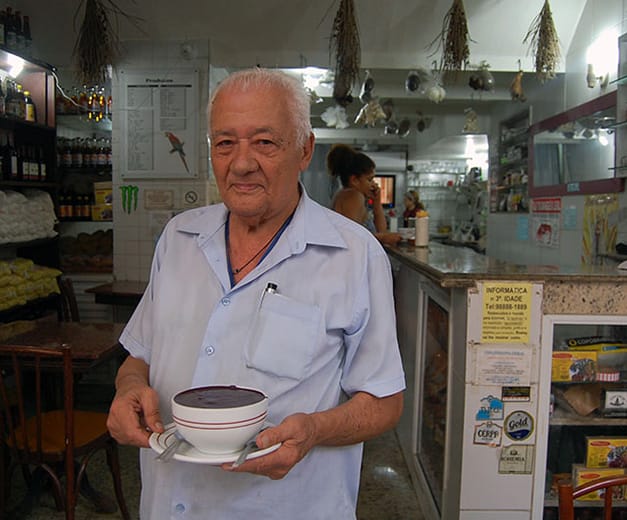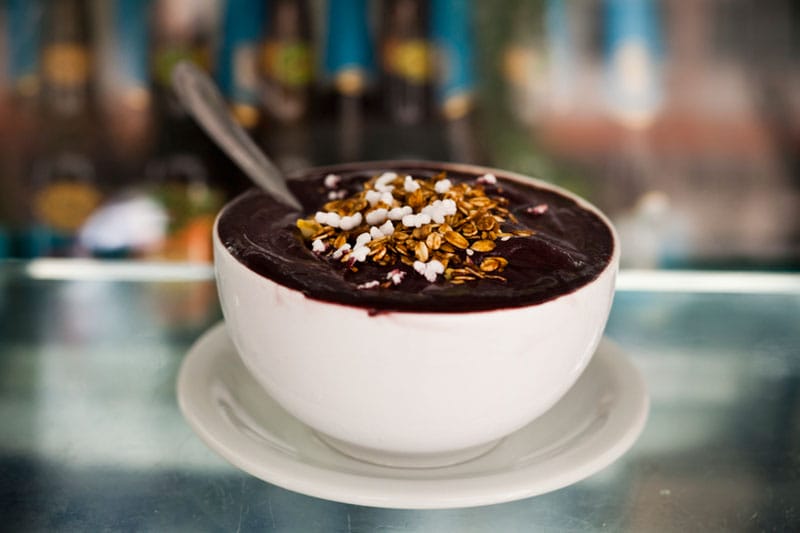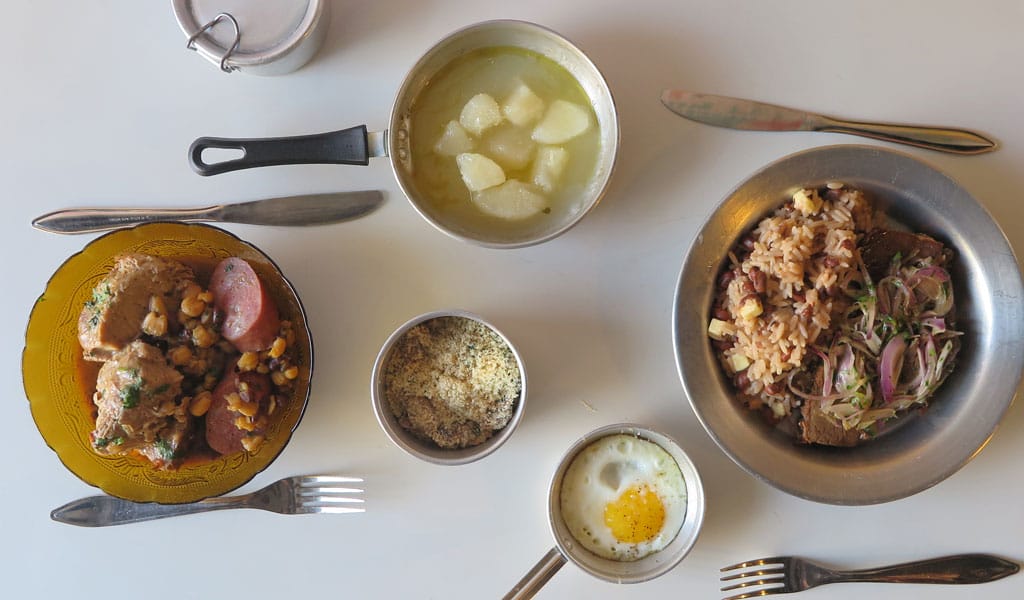Arataca boasts a title so extraordinary that, were it more widely known, we would expect the modest Copacabana snack bar to be covered with colorful Nossa Senhora do Bonfim blessing ribbons so that generations of pilgrims could light white, tapered candles and lay baskets of offerings at its sidewalk entrance. That designation is: First Açaí – the Amazonian superberry – served in Rio de Janeiro. Local lore says that the slushy, purple drink was first served here 59 years ago, and it was a hit. Nowadays, you’ll see cariocas all over the city with the drink’s trademark ink-stained teeth.
Arataca was opened by two immigrants from the northeastern state of Pernambuco. One was in the military and, in his travels through Brazil, he developed a taste for the highly unique cuisine of the country’s north, particularly that of Pará state, considered the gateway to the Amazon region. Pará is also the cradle of the Amazonian berry açaí, which is sold in barrels at riverside marketplaces in the commercial and political capital of the state, Belém.
These days in Rio, it’s only in places like Arataca – an authentic gem in the midst of touristy Copacabana – that you will find açaí in its pure form: smooth when blended into a drink, with an earthy flavor until you add sugar or guaraná syrup. (Special note for cult followers of Tacacá do Norte, a Flamengo snack bar with a similar menu to that of Arataca: The açaí here is a bit thinner and soupier, which is nice for sipping, though we like Tacacá’s velvety approach to the drink, too.) Elsewhere in the city, the drink is served as an icy, purple slushy, as tasty as it is cavity-inducing due to the amount of sweetener added. Indeed, while Americans consume the imported berry as an antioxidant superfood, the residents of Rio – and Brazilians in general, aside from those in the Amazon region – have taken to the drink by making it like candy.
Other staples at Arataca include the tacacá soup, a thin, lemony shrimp stew made with gobs of tapioca and the mouth-numbing jambu leaf. (This soup acquires as many loyal consumers as it does skeptics.) We tried the caruru, an okra and shrimp mashup that paired well with the spicy, yellow tucupi sauce – made from a type of Amazonian manioc root – which is lemony at first taste, and then delivers a powerful hot-and-sour kick.
Arataca also functions as a general store for the wares that merchants sell in the ports of Belém. These include specialty products like cashew apple preserves and jam made from buriti, the yellowy, pulpy fruit of the moriche palm (and a cousin of the Asian snake fruit, so named due to its less-than-appetizing exterior). There are also some of the hefty staples used in preparing northern cuisine, like bags of stryofoam-y white tapioca beads (we like these – they’re an alternative topping to granola for açaí) and the thick, yellow, teeth-cracking farinha d’água, a labor-intensive food topping 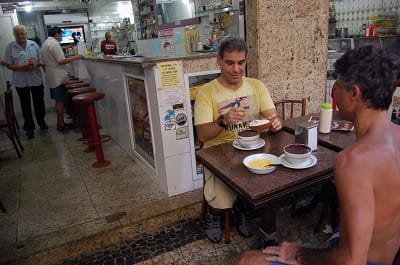 made from manioc root. Some Brazilians swear by the soaps and oils from copaíba oil, a would-be cure-all ointment that comes from a tree trunk.
made from manioc root. Some Brazilians swear by the soaps and oils from copaíba oil, a would-be cure-all ointment that comes from a tree trunk.
While the two pernambucanos who established Arataca eventually sold the place to another owner, white-haired waiter Mário, who came to Rio 59 years ago to work for them, has never left. He has a butler-like presence at the small shop and is a reminder of the ways that, especially for an older generation, food service in Brazil was a career to be treated with dignity, not one that was just a passing-through job while en route to another. He’s 82 and retired in 1984, but he stills comes to work here each day because he says it’s cheaper than paying a gym membership to get exercise.
Arataca’s fluorescent lighting, odd dried stems and fruits dangling from its ceiling, and white tiled bar with high wooden bar stools all hark back to a time when ambiance was an organic rather than designed production. In Rio’s South Zone, where prices and pretensions have spiraled in recent years, Arataca, like Mário, seems in no rush to change.
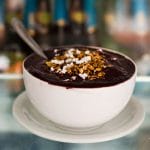 May 28, 2013 Tacacá do Norte
May 28, 2013 Tacacá do Norte
The eyes of Tacacá do Norte’s harried staff widen as yet another customer arrives during […] Posted in Rio December 22, 2017 Best Bites 2017
December 22, 2017 Best Bites 2017
Brazil’s economic crisis has hit Rio hard this past year, and the culinary scene was by […] Posted in Rio June 1, 2017 Kalango
June 1, 2017 Kalango
The calango is a tiny lizard commonly found in the hottest, driest and poorest parts of […] Posted in Rio
Published on February 22, 2016
Related stories
May 28, 2013
RioThe eyes of Tacacá do Norte’s harried staff widen as yet another customer arrives during the lunchtime rush. The bedroom-sized snack bar can barely hold one line of chairs around its bar but they have somehow managed to squeeze in two. Impatient regulars shake hands and whistle “psst” to the sheepish young men staffing the…
December 22, 2017
RioBrazil’s economic crisis has hit Rio hard this past year, and the culinary scene was by no means immune from the downturn. Some famous restaurants and bars closed their doors for good. But the city hasn’t given up. In fact, if some doors have closed, a lot more have opened. Because now creativity is being…
Visit unforgettable Rio botequim, on our gastropub crawl.
June 1, 2017
RioThe calango is a tiny lizard commonly found in the hottest, driest and poorest parts of Brazil’s Northeastern countryside, and in popular culture, the calango is also a symbol of hunger. Someone who eats calango is driven to do so because he has nothing else to eat. Thankfully, at Kalango there’s plenty to eat. Kalango (the “K”…







































